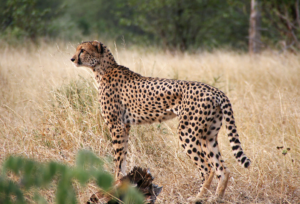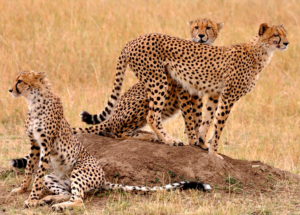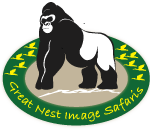Cheetah | the fastest cat
Cheetah | the fastest cat : scientifically known as Acinonyx jubatus is a large cat native to Africa and also the fastest land animal. It is estimated to be capable of running at 80 to 128 kilometers per hour (50 to 80 mph). It also has the fastest reliably recorded speeds being 93 and 98 kilometers per hour (58 and 61 mph). These animals generally live in three main social groups; females and their cubs, male “coalitions” and solitary males. While females lead a nomadic life searching for prey in large home ranges, males are more sedentary. They may instead establish much smaller territories in areas with plentiful prey and access to females. However, these big cats are active mainly during the day, with peaks during dawn and dusk.
Physical characteristics
 Size
Size
Adult cheetah males are typically larger than females. The body length of cheetah ranges from 112 to 150 cm (3.93-4.92 ft). The tail lengths are between 60 to 80 cm (2-2.62 ft) while the height at the shoulder ranges from 67 to 94 cm (2.2-3.1 ft). Their weights average from 21 to 72 kilograms (46-158 lb.), with the average male larger than the average female.
Eyes
Cheetahs have small, thin-boned skull with a relatively flat face and reduced muzzle size. In fact, these adaptations allow their large eyes to be positioned for maximum binocular vision. There is also a high concentration of nerve cells leading to the optic nerve. This generally allows them to detect prey in open habitats that move against the horizon. A nictitating membrane further shields and protects the eyes during fast sprints.
Paws
The cheetahs have paws that are narrower than other larger felids, resembling the paws of dogs rather than cats. They also have claws that are blunt, slightly curved and only semi retractable. The claws are like running spikes, used to increase traction while pursuing prey.
Tail
The tail of the cheetah can measure 66 to 84 cm (26-33 in), which is about two-thirds of its body length. During fast sprints, a cheetah’s paws have minimal contact with the ground. At such times, a cheetah’s tail stretches out and acts as a counter balance during sharp turns. The flattened tip of the tail also acts like a rudder to guide directions.
Head
These animals have relatively small heads, small ears and high set of eyes. Rapid acceleration generally requires a cheetah to have highly oxygen intake adaptations including enlarged nostrils and extensive air-filled sinuses. While running, a cheetah’s repertory system allows it to go from a normal rate of 60 breaths per minute to 150 breaths per minute. Furthermore, less developed whiskers around the face suggest that cheetahs are not as active hunting at night compared to other felids.
Dentition
They have weak jaws and smaller canine teeth compared to other large cats. However, this leaves them vulnerable when it comes to defending captured prey from other larger predators.
Habitat
Cheetahs appear to be less selective in terms of habitat choice than other felids and inhabit a variety of ecosystem. These include; areas with greater availability of prey, good visibility and minimal chances of encountering larger predators are preferred. They seldom occur in tropical forests and have been reported at elevations as high as 4,000m (13‚000 ft). An open area with some cover such as diffused bushes; is probably ideal for them. This is because it needs to stalk and pursue its prey over a distance. Unlike other big cats, the cheetah tends to occur in low densities typically between 0.3 and 3.0 adults per 100 square kilometers.
Built for speed
It is generally the world’s fastest land animal and Africa’s most endangered big cat. Uniquely adapted for speed, the cheetah is capable of reaching speeds greater than 110 kilometers per hour in just over 3 seconds. The cheetah’s unique body structure; semi-retractable claws, flexible spine, long legs and tail allows it to achieve the unbelievable top speed of 100 kilometers per hour (70 mph). In fact, its body is narrow and lightweight with long slender limbs. Furthermore, specialized muscles allow for a greater swing to the limbs increasing acceleration. Cheetah’s foot pads are hard and less rounded than other cats. In general, they function like tire treads providing them with increased traction in fast, sharp turns. The shorter blunt claws, which are considered semi-retractable, are closer to that of a dog than of other cats.
Flexible and fast
The cheetah’s long muscular tail works like a rudder, stabilizing and acting as a counter balance to its body weight. Swinging the tail back and forth continually adjusting to the movement of prey allows for sudden sharp turns during high-speed chases. Their shoulder blade does not attach to the collar bone thus allowing the shoulders to move freely. The hip and the shoulder extension allows for a large range of extension during running thus making both its exceptional stride length. The length between their steps is 6 to 7 meters (21 ft) and four strides are completed per second. There are two times in one stride when the cheetah’s body is completely off the ground. Once when all four legs are extended and once when all four legs are bunched under the body.
Behaviors
 They are solitary animals and males have been seen living in coalitions. They generally appear extremely tolerant of close proximity to other males. The related members of the coalition will even take part in play and physical contact such as grooming. On the other hand, the unrelated males will generally stick to themselves while remaining in the coalition. Like all females, there are some males who stick to themselves who do not belong to the coalition. In addition, they never stay in one place for long and are referred to as nomads. At times, a male will company a female for a short while after mating, but most often the female is alone with the cubs. Mothers basically spend a long time teaching their young ones how to hunt.
They are solitary animals and males have been seen living in coalitions. They generally appear extremely tolerant of close proximity to other males. The related members of the coalition will even take part in play and physical contact such as grooming. On the other hand, the unrelated males will generally stick to themselves while remaining in the coalition. Like all females, there are some males who stick to themselves who do not belong to the coalition. In addition, they never stay in one place for long and are referred to as nomads. At times, a male will company a female for a short while after mating, but most often the female is alone with the cubs. Mothers basically spend a long time teaching their young ones how to hunt.
Diet
These cats mostly prey on small antelopes like the Thomson’s gazelles as well as impalas but also hunt small mammals and birds. It gets close to the prey as possible then in a burst of speed, it tries to outrun its quarry. Once the cat closes in, it knocks the prey to the ground with its paw and suffocates the animal with a bite to the neck. Afterwards, it eats quickly and keeps an eye out for scavengers. Unfortunately, the cheetah’s speed can’t be maintained for more than a few hundred meters before the individual overheats and that’s why the majority of hunts always result in failure.
Mating
Female cheetahs lead solitary lives unless accompanied by their cubs. Unlike males that prefer to live in a set territory with their coalition, females move within home ranges. However, the home ranges for the female cheetahs depend on the distribution of prey. Estrus in female cheetahs is not predictable and this is one of the reasons why it is difficult to bread cheetahs in captivity. Mating receptivity depends on environmental factors that researchers have found are triggered by the proximity of males and their scent markings. Estrus lasts up to 14 days and females will mate with multiple males during this period. Male cheetahs that encounter a female in estrus will stay with her and mate up to three days. When it comes to mating, there are no dominant males within the coalition that claim exclusive access to females so, all males within a coalition will mate.
Hunting
Unlike other big cats, cheetahs are diurnal; they hunt in early morning and late afternoon. In addition, they climb termite mounds to get an optimal vantage point for spotting prey against the horizon. The hunt has got several components; prey detection, the chase, stalking, tripping and killing by means of a suffocation bite to the throat.
Reproduction and development
Sexual maturity occurs at 18 to 23 months and the gestation period is about 3 months and the average litter size is 6 cubs. While there is no definitive breeding season, a majority of births occur during the wet season. Births occurring during this time of the year coincide with the gazelle birth season, increasing food resources for the cheetah. Cubs are smoky-grey in color with long hair also known as a mantle, running along their backs. Cub mortality is high in both the wild and captivity and on average 30 percent of all cubs born in human care die within one month of birth. On the other hand, in Serengeti National Park (Tanzania), about 90 percent die before reaching three months of age. At six weeks, the young are strong enough to follow the hunt and when they are about six months older, the mother will capture live prey for them to practice killing.
Vocalizations
Unlike other big cats, cheetahs don’t roar but they growl when facing danger and they vocalize with sounds. Equivalent to a high-pitched chirp or bubble and they bark when communicating with each other. However, they can also purr while both inhaling and exhaling.
Facts about Cheetahs
Tear Marks
Cheetahs have built-in sun glare protection around their eyes. In addition, the tear marks run from the inside corners of their eyes down to the outside edges of their mouth. In fact, these marks help reflect the glare of the sun when they are hunting during the day. These marks also work like the sights on a rifle to help the cheetah aim and stay focused on their prey when they are hunting.
Tail like a rudder
The cheetah has a long muscular tail that has a flat shape which almost functions like a rudder on a boat. This is because they use it to help control their steering and keep their balance when running very fast.
Spotted skin
Their fur is covered in solid black spots, and so is their skin. The black fur actually grows out of the black spots on their skin.
Cleat feet
It has got semi non-retractable claws like the dog claws that gives it a lot of traction when running. The pads of most cat paws are soft but the cheetah’s pads are hard kind like rubber on a tire. This also helps them grip the ground when they are running so fast.
Funny haircut
Cheetah cubs have long tall hair that runs from their neck all the way down to the base of their tail known as the mantle. The mantle also makes a cheetah cub look like a honey badger and makes them blend into the tall grass. This helps keep them safe from threats like hyenas and lions.
Feeding
Cheetahs are carnivores and feed mostly on smaller antelopes like steenbok, springbok, Thomson’s gazelle, impalas, duikers etc. They usually chase down their prey and then bite its throat, killing it by cutting off its air supply or call it suffocation.
Where are cheetahs found?
These animals are confined mostly to dry open grasslands of Sub-Saharan Africa. However, in Uganda, you can find them in Kidepo valley national park and Pian Upe wildlife reserve while on your safari.






